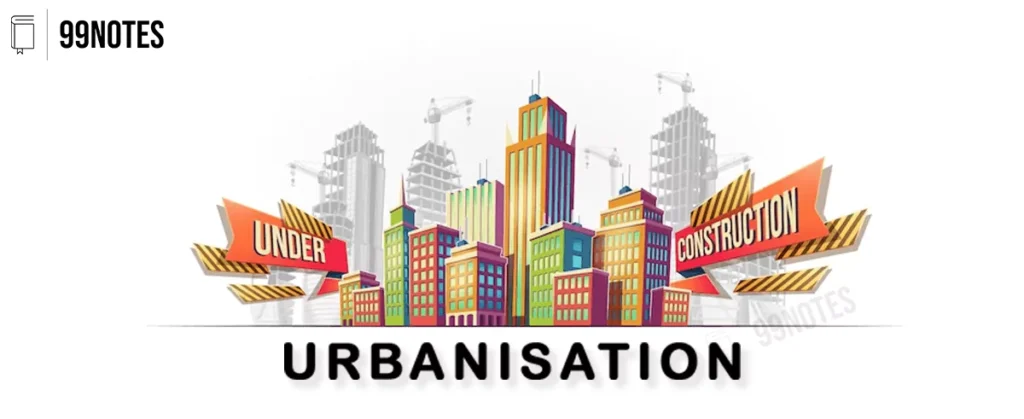
Urbanisation UPSC Free Notes Download
Urbanisation
Urbanization is an important topic to study for the UPSC Civil Services Exam because it is a global trend that has significant implications for society, the environment, and the economy. Understanding the causes and consequences of urbanization can help policymakers and decision-makers develop strategies to address the challenges and opportunities that it presents.
In particular, studying urbanization can help aspiring civil servants understand the complex interplay between economic, social, and environmental factors that shape the development of cities. It can also provide insight into the ways in which urbanization can impact public health, transportation, and other key policy areas.
Furthermore, studying urbanization can help aspiring civil servants understand the role of government in shaping the development of cities, and the various strategies that can be used to address the challenges and opportunities that urbanization presents. This can include policies related to affordable housing, transportation, environmental protection, and other key issues.
Overall, studying urbanization is an important aspect of preparing for the UPSC Civil Services Exam, as it can provide a deeper understanding of the complex forces shaping the development of cities and the role of government in addressing the challenges and opportunities that urbanization presents.
Urbanization refers to the process of increasing the proportion of a population that lives in urban areas, and is often accompanied by societal, economic, and technological changes. It is a global trend that has been underway for centuries, and it has significant implications for the environment, public health, and social structures.
In the past few decades, urbanization has accelerated dramatically, particularly in developing countries. According to the United Nations, more than half of the world’s population now lives in urban areas, and it is estimated that by 2050, this figure will rise to nearly two-thirds.
There are several drivers of urbanization, including economic development, population growth, and technological advances. Economic development often leads to the growth of cities, as people flock to urban areas in search of employment and opportunities. Population growth, both natural and through immigration, also contributes to urbanization, as more people are drawn to the amenities and opportunities available in cities. Technological advances, such as improved transportation and communication systems, also make it easier for people to live and work in urban areas.
Various factors for urbanisation
Industrialisation
Industrialization is a tendency that signifies a transition away from the conventional agricultural economy and toward the innovative non-agricultural economy, resulting in the formation of a more modern society. As a result of the industrial revolution’s increase in the number of available employment, a higher number of people have relocated from rural to urban locations.
Industrialisation has increased employment options by allowing individuals to work in current industries in job categories that stimulate economic growth.
Commercialisation
Commercial activity and commerce have a substantial impact on the growth of cities. The distribution of products and services and commercial transactions in the modern age have resulted in the establishment of modern marketing institutions and means of exchange, both of which have significantly contributed to the expansion of urban areas.
It is often considered that when commercialization and trade emerge, towns and cities provide more business prospects and returns than rural locations.
Community-Based Advantages and Services
Living in a city or town has several social advantages over living in the country. This would include improvements to educational institutions, living standards, sanitation and housing, medical treatment, recreational facilities, and the quality of social life as a whole.
Employment Opportunities
People living in rural regions are continuously lured to urban and suburban areas in quest of better work prospects than they can find in their native villages.
Therefore, the bulk of individuals typically travel to metropolitan regions in search of well-paying employment opportunities. Urban regions provide many job prospects in all sectors of economic growth, including public health, education, transportation, sports and recreation, industries, and businesses. Consequently, urban places attract individuals from throughout the globe.
Adjustments to new lifestyles brought on by modernization
The modernization that occurs has a tremendous influence on the urbanisation process. Due to the greater availability of enlightenment, liberalisation, medical facilities, dress norms, enlightened communication, infrastructure, and other social amenities, people think they may live a happy life in cities. In addition, as metropolitan regions grow more technologically adept and possess highly sophisticated communication, this trend will continue.
Urbanization has both positive and negative consequences. On the positive side, it can lead to economic growth and development, as cities are often centers of commerce, industry, and innovation. It can also provide access to education, healthcare, and other social services, as well as cultural and recreational amenities.
However, urbanization also has negative consequences, such as environmental degradation, congestion, and social inequality. The rapid expansion of cities can put pressure on natural resources, leading to deforestation, pollution, and other environmental problems. It can also lead to traffic congestion, air pollution, and other forms of environmental degradation. In addition, urbanization can exacerbate social inequality, as the cost of living in cities is often higher than in rural areas, and those with lower incomes may struggle to afford housing and other basic necessities.
One of the major challenges of urbanization is ensuring that cities are sustainable and livable for all residents. This requires addressing issues such as affordable housing, transportation, and environmental protection. It also requires addressing social and economic inequality, and ensuring that all residents have access to education, healthcare, and other essential services.
To address these challenges, governments and other organizations are implementing a range of strategies, including urban planning and design, transportation improvements, and environmental protection measures. For example, they may implement policies to promote the use of public transportation, reduce air pollution, and encourage the development of green spaces. They may also implement measures to address social inequality, such as affordable housing programs and job training initiatives.
In conclusion, urbanization is a global trend that has significant implications for society, the environment, and the economy. While it can bring economic development and access to amenities and services, it also has negative consequences, including environmental degradation and social inequality. Ensuring that cities are sustainable and livable for all residents will require a range of strategies, including urban planning, transportation improvements, and measures to address social and economic inequality.
Overall, studying urbanization is an important aspect of preparing for the UPSC Civil Services Exam, as it can provide a deeper understanding of the complex forces shaping the development of cities and the role of government in addressing the challenges and opportunities that urbanization presents.
Causes of the Urbanization:
- Industrialization:
- Growth Services Centres: As cities expand, living standards and trade increase, leading to a concentration of services like retail, entertainment, etc, in urban areas, which attracts more people, causing the urban area to expand gradually.
- Population Growth: Over the years, India has experienced significant population growth, which has led to increased pressure on resources and a subsequent migration of people from rural to urban areas.
- Infrastructure Development: An emphasis on infrastructural Development, such as roads, transportation networks, and housing, has led to urban growth. Better infrastructure has made urban areas more accessible and conducive to economic activities.
Challenges of the Urbanization:
- Overcrowding: An increase in urbanization leads to population growth, which leads to overcrowding. It encourages deviant behaviour, spreads diseases and creates conditions for mental illness, alcoholism and riots.
- Housing shortage and slum: there is an acute shortage of housing in Urban areas, and this problem has tended to worsen over the years due to the rapid increase in population. The demand for affordable housing often outstrips supply, leading to the proliferation of slums, inadequate living conditions, etc.
- Traffic Congestion: As urban areas expand, traffic congestion becomes a significant issue. Lack of planned and adequate arrangements for traffic and transport is another problem in urban areas that causes pollution.
- Pollution: the indiscriminate growth of industrial and chemical plants polluting the atmosphere with smoke and toxic gases, untreated effluents into the nearby rivers, etc., contributed to an increase in pollution in the urban area.
- Environmental Degradation: the process of urbanization exerts pressure on natural resources and ecosystems. Deforestation, loss of green spaces, and improper waste management are the common problems related to urbanization, causing the deterioration of the environment.
Solutions:
Addressing the complexity of urbanization requires a holistic and multi-dimensional strategy involving urban governance, the roles of government, NGOs and individual citizens.
- Robust Urban Governance: to address the issues regarding urban governance, a robust urban governance structure and institutions are required. This encompasses effective urban planning, transparent decision-making mechanisms and inter-departmental coordination within the government.
- Adopting sustainable urban planning: Adopting sustainable urban planning, such as promoting compact and mixed-use development, preserving green spaces, etc., is crucial for managing urban growth and mitigating environmental impacts.
- Creating Job Opportunities in Rural Areas: initiatives should be undertaken by the government to establish projects in rural areas that offer employment opportunities.
- Development of Infrastructure: The government should prioritize infrastructure investment to cater to the growing demands of urban areas. This involves enhancing transportation networks, expanding public transit systems, upgrading water supply and sanitation, etc.
- Affordable Housing: The government should concentrate on providing affordable housing through policies that promote the construction of cost-effective housing, implementation of slum redevelopment projects, etc.

